As a start-up, how do you find out more about who your competitors are and what they are working on? How do you find out if your product has a differentiating factor? Do you have a first mover's advantage?
As an intellectual property executive, how do you gain insight into opportunities and risks for a particular technology?
A patent landscape analysis can provide some insight into the above questions by giving a high-level view of patenting activity for a specific technology. A patent landscape report identifies technology hot spots, where companies are investing heavily in research and development, and technology areas that are more open for development. This helps in making informed decisions on the technologies in which to invest time and money, or technologies in which it may be more viable to license rather than develop anew.
Case Study: A 2019 Snapshot of Graphene Manufacturing
Since the seminal paper on graphene by Konstantin Novoselov and Andre Geim in 2004, much research has been conducted on its properties and applications. However, even with the demonstration of novel graphene-based technologies, one factor that hinders the commercialisation of graphene (and its related products) is in large-scale manufacturing.
This study provides a snapshot of the current status of graphene manufacturing by extracting information from patent applications filed within this technology space. This study aims to shed some light on the latest trends in graphene manufacturing technologies and the business outlook of some players in this field.
Filing trend since 2004
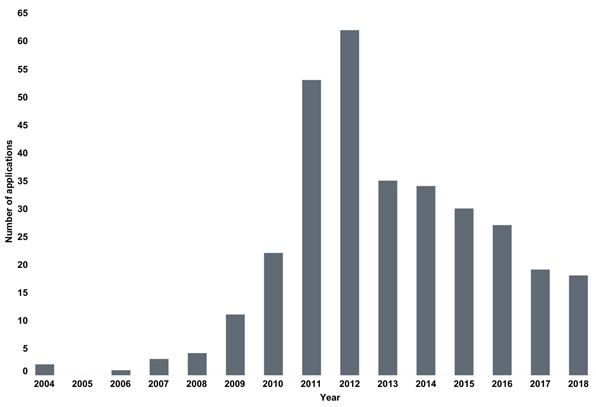
Patent filings for graphene manufacturing increased exponentially from 2004 to 2012 and thereafter declined.
While the trend for graphene manufacturing appears to be on a downtrend, total patent filings for graphene (manufacturing and applications) are trending upwards with at least 500 applications filed each year from 2011 to 2018 (data not shown). This suggests that the focus in recent years has shifted to the applications of graphene.
Technology Distribution
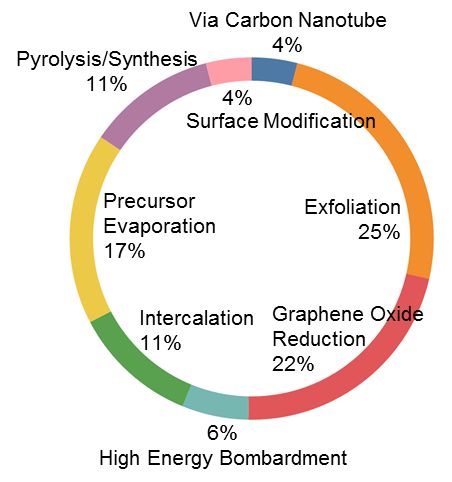
Of the total filings, exfoliation techniques and precursor evaporation techniques comprise 25% and 17% of the filed applications respectively.
Filing trend of selected technologies
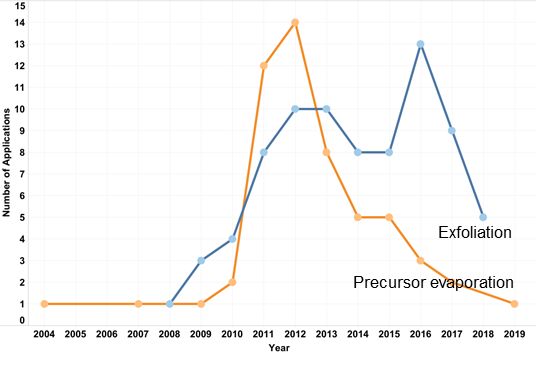
While exfoliation and precursor evaporation techniques were widely explored until 2012, interest in precursor evaporation techniques appears to taper off after that, and interest in exfoliation tapers after 2016.
The shift in interest away from manufacturing towards applications is allude to the difficulties faced when scaling the production of graphene and/or the cost and consistency of the manufactured graphene product.
Distribution of Exfoliation Technologies
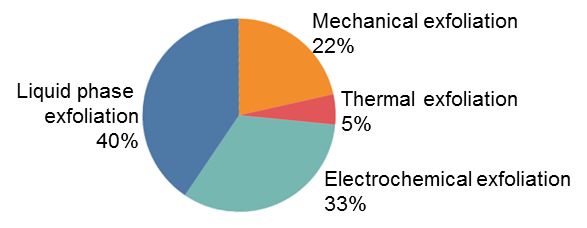
Of the exfoliation type technologies, liquid-phase exfoliation is the most explored technology.
Distribution of Precursor Evaporation Technologies
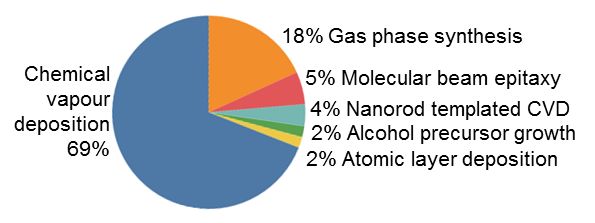
Of the precursor evaporation type technologies, chemical vapour deposition (CVD) is the most explored technology.
The above results suggest that exfoliation and precursor evaporation technologies were initially considered the most promising, but a barrier to a scalable approach still exists. Moving forward, the published applications provide a rich bed of material from which to develop new exfoliation and precursor evaporation technologies, or for developing new techniques (for example, by using a combination of technologies).
Some Players in Graphene Manufacturing
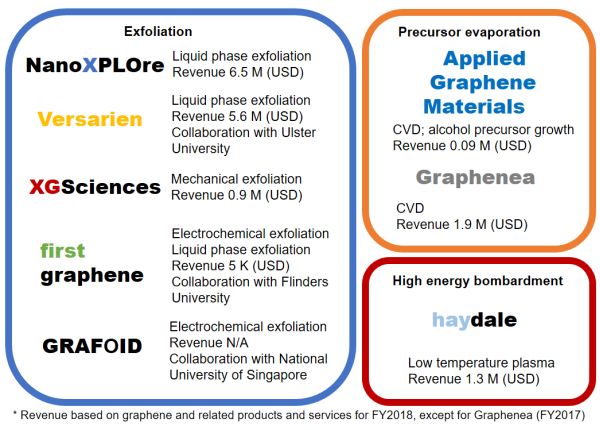
This graphic above shows selected companies that are manufacturing graphene and some techniques they are using.
Revenues of the companies are spread over a wide range due to the different business models used and different stages the companies are currently at.
First Graphene has only recently (May 2019) obtained approval to manufacture and sell graphene in Australia.
Grafoid's electrochemical exfoliation process was developed in conjunction with the National University of Singapore. Grafoid was cited as one of the top four key graphene vendors in a global graphene market analysis (Global Graphene Markets 2012–2016; Infiniti Research Limited).
Many of these companies not only focus on graphene manufacturing, but also develop graphene-based applications in fields such as energy storage, composites, elastomers, and coatings. For example, XG Sciences is working with Samsung to co-develop graphene-based batteries, with Ford for vehicle parts (for improved mechanical and heat endurance properties and noise reduction), and with Callaway Golf for graphene-golf balls (increased control, higher driving speeds and greater distance off the tee).
Jurisdictions of interest for selected players based on patent filings
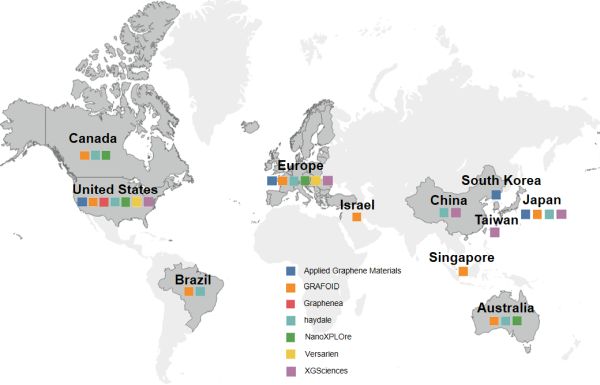
The map highlights possible manufacturing sites and potential markets of interest for these companies. The United States is identified as a major jurisdiction of interest for all companies.
First Graphene is not reflected on the map as their liquid phase exfoliation technology was recently filed as an international patent application and has yet to enter national phase.
Conclusion
Patent landscape analysis can be a valuable tool for analysing the market, by shedding light on what other companies are focusing on. It is with this in mind that one can make informed business decisions.
The results of this study suggest that while the graphene industry is moving away from graphene manufacturing, interest in graphene applications is still growing. This suggests there remains an opportunity for a company to dominate large-scale graphene production.
Methodology: The Lens was used for the patent search, based on (title:(graphene OR graphine OR grapheme OR grafene) OR abstract:(graphene OR graphine OR grapheme OR grafene) OR claims:(graphene OR graphine OR grapheme OR grafene)) AND (classification_ipcr:(C01B32/184) OR classification_ipcr:(B82B*) OR classification_ipcr:(B82Y40*)); application filed from 1 Jan 2004 – 1 July 2019. Granted and Pending application were filtered based on (title:(manufac* OR production OR scale OR process) OR abstract:(manufac* OR production OR scale OR process) OR claims:(manufac* OR production OR scale OR process)). Data was further refined based on title, abstract and claims to remove graphene oxide, graphane, manufacture of composites, functionalisation methods, method of transfer, applications, aggregate, shell, doping, multilayer, crosslinking, material, coating, substrate, patterning, 3D, janus type and nanotube. Information relating to companies' revenue and collaboration were obtained from newsfeeds and financial statements.
The content of this article is intended to provide a general guide to the subject matter. Specialist advice should be sought about your specific circumstances.

